Pup Development- Week three
Interaction with the babies in the form of playing and nurturing by the breeder/owner will ensure that the litter is well socialized.
During this week the babies’ ability to get around increases. Safety is now a major issue.
When removing the babies from their cage for play sessions, take care that the play environment is protected. Cover couches, or chairs having multiple cushions, with a sheet or blanket. This way the babies can’t disappear between the cushions and get lost or squished. It is difficult to get a pup out of a couch and can sometimes require dismantling furniture.
Be sure to count the babies every time you return them to the cage after play or cleaning.
If you have children, supervise pup handling. By the end of week three the babies will be very quick and hard for little hands to hold onto.
After you open the cage for any reason do not look away. The babies (and the mother) can get out quicker than you can imagine. Make sure that all little paws are away from the cage door when you are closing it and be sure to latch the cage securely.
Days 15-21
| The litter is now 15 days old and there is a lot more activity in the nest. Once their eyes are open, and vision is clearer, the babies start exhibiting new behaviors. They attempt to sit up (balancing on their hind legs and tails) to groom and to eat. They are showing interest in sampling the food provided for the mother and healthy food such as vegetables, block, and grains can now be provided. At this age the babies are able to run. |
 |
| The babies are spending less time sleeping and more time playing and exploring their environment. This is the age where the mother begins to spend less time in the nest, and the offspring will seek out their mother for nursing. The babies are old enough to drink without a nipple and some breeders will supply them with occasional soy formula to give the mother a break.
At this age dumbo ears are almost perpendicular to their heads.
|
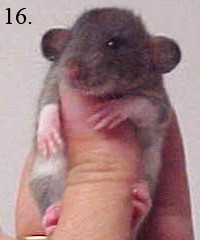 |
| During this week of development breeders often remove the litter from the birth environment. Housing the litter in a larger environment (such as a wire cage) with ramps, different levels, tubes, hammocks, and climbing areas will stimulate them and increase their motor development. It is important to make sure that bar spacing prevents the babies from escaping or getting stuck in the openings.
|
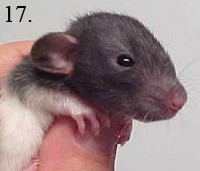 |
| The babies are now eating everything in sight, spending more time awake, and roaming farther. They can now climb the cage sides and even hang from the top. The babies enjoy playing with each other and with their owner.
|
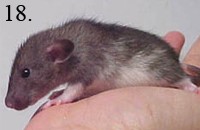 |
| By this age the babies are nursing less and do not generally consume all of the milk the mother offers during each nursing session. Even so, be careful not to give too much extra food to the babies. Over supplementation of certain foods can lead to health issues later in life especially with foods high in fat or sugar. It is easier now to see which of the babies are dumbo-eared (day 19 photo) and which are standard (day 20 photo).
|
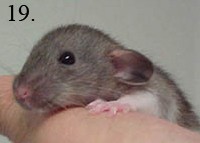 |
| As their appearances become more distinctive so do their individual personalities. Some are shy while others have outgoing personalities. It is not uncommon for breeders to seek out the shy/fearful babies more often for handling in an attempt to make them more outgoing and confident. This is known as “forced socialization.” |
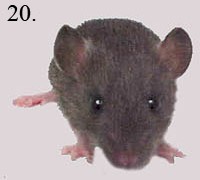 |
| In laboratories pup rats are often removed from their mothers and weaned at 3 weeks of age. Left with the mother, weaning will occur, naturally, at a later time. Letting the rats wean naturally has both health and behavioral benefits. |
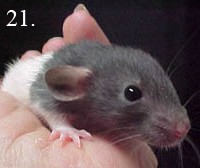 |
Photos by Joanne “Bella” Hodges









